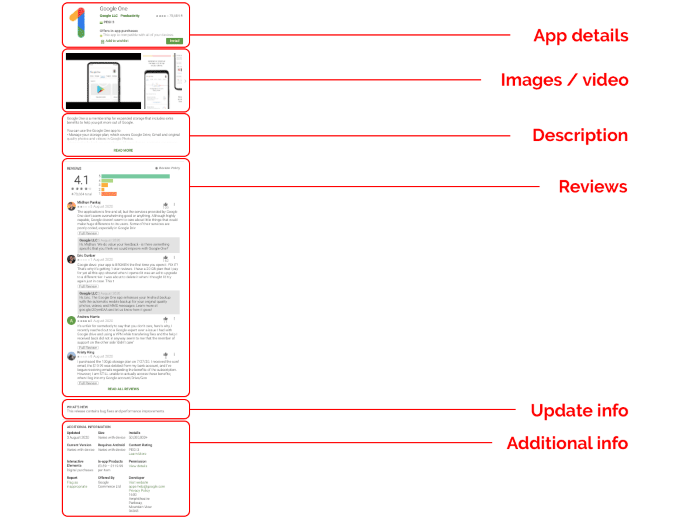A Complete Guide To App Store Optimization (ASO)
A mobile strategy is critical to your business presence, considering the saturation of mobile devices.
This is where app store optimization (ASO) comes into play.
In this article, you’ll learn:
- What is app store optimization?
- How does app store optimization work?
- How do you optimize for Google Play & Apple App Store?
-
What Is App Store Optimization?
Downloads, usage, and in-app spending continue to rise, but many users prefer to use a select few apps more consistently.
Discoverability has never been harder, but the rewards of locking in loyal users are bigger than ever – so maximizing visibility in app stores is crucial.
App store optimization (ASO) describes the process of optimizing the listing pages for your mobile app in app stores like Google Play and Apple’s App Store.
You may come across alternative phrases like “app store marketing” or “mobile app SEO,” but they all refer to the same thing.
The goal is to maximize the visibility (and downloads) of your app for relevant searches – basically, SEO for your mobile app rather than your website.
In many ways, the optimization process for ASO is very similar to SEO; in others, not so much.
Ultimately, ASO aims to maximize app installs while product development works on monetization, engagement, retention, etc.
An effective app store optimization strategy keeps new users coming in while your development team (hopefully) keeps existing ones active and spending.
With the right retention rates, app store optimization acquires the new users you need to drive meaningful growth.
The goal of ASO is nearly always app downloads, but supplemental goals can include items such as:
- Increased brand exposure.
- Positive app reviews and ratings.
- More frequent and increased volumes of app reviews.
- Audience engagement.
- Additional marketing channel diversification.
How Does App Store Optimization Work?
If you’re new to app store optimization, it might help to think of it as SEO for your mobile app.
Except, rather than optimizing a website to show in search engines, you’re optimizing your mobile app listings for the relevant app stores.
In this sense, you could argue ASO is more like optimizing a Google Business Profile to show in Maps and local results.
The other key difference is you’ve got two major mobile app stores to optimize for: Google Play and Apple’s App Store.
These aren’t the only two app stores worth considering, especially if you’re developing apps for other devices (TVs, games consoles, etc.), but they are the biggest – by far.
According to Statista insights from Q3 2022, here are the top three app stores based on the number of available apps:
- Google Play: 3.55 million.
- Apple App Store: 1.64 million.
- Amazon Appstore: 0.48 million.
As a result, most ASO guides focus on optimizing app listings for Google Play and Apple App Store. Aside from being the top two platforms, the optimization process is a little different for each.
Organic Optimization: Your ASO Foundation
The key ingredient missing from many ASO marketing delivery approaches is organic search optimization and integration of app stores within the broader organic marketing mix.
There is more overlap between ASO and SEO than direct competition between the two.
The integration of these areas, and the application of consistent focus on ASO, can support numerous search marketing gains.
You may be surprised to discover that many of the traditional search engine optimization tactics that work for search engine performance, such as Google and Bing, can also be directly applied to ASO.
Examples of this include:
- App name, title, and URL optimization.
- Keyword research for ASO.
- App rating and reviews generation and handling.
- Deep linking within mobile apps.
- Indexation of Apps in Google search engine results pages (SERPs).
- Click-through rate (CTR) optimization.
The biggest marketing mistake, however, when it comes to integrating SEO and ASO is overlooking the role of the website in driving volumes of referral visits directly to your store page and app downloads section.
The Most Important App Store Ranking Factors
Like search engines, app stores don’t reveal the details of their algorithms to the public.
That being said, the following seven ranking factors are key, functional components of all major app stores:
- App name or title.
- App descriptions (including keywords).
- Installs.
- Engagement.
- In-app purchases and events.
- User reviews.
- Updates.
What Do Users Want From An App Store Listing?
the key factors on your mobile app page that determine whether users hit the install button?
- App icon: On most app stores, your app icon is the most visually prominent element on results pages and recommendation lists.
- App details: This includes your app name/title and, usually, some short descriptive text explaining the purpose of your app.
- App rating: Most platforms show the average rating/review score for your app in search results and at the top of your app listing page.
- App description: With Google Play and the App Store, users can see a brief description on your listing page and they can click to see the full description – so that first sentence or two is crucial.
- Visuals: This includes any feature images, screenshots, and demo videos that you can add to your listing, showcasing the key benefits and user experience of your app.
- User reviews: Unless users are already familiar with your app, they’re probably going to browse through some reviews from existing users.
Here, you can see this in action.
Much like SEO, app store optimization is a careful balance of optimizing to maximize visibility in app stores while prioritizing the needs of your users.
Google Play Vs. App Store: Key Differences
Google Play and the App Store are more similar than different when it comes to app store optimization.
Firstly, the ranking factors are very similar, and the differences are mostly technical – for example, Google and Apple handle keywords differently.
Here’s a quick summary of the main ranking factors for Google Play and the App Store.



